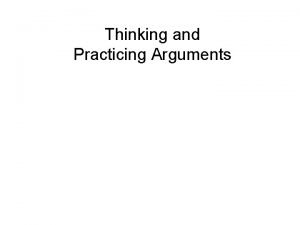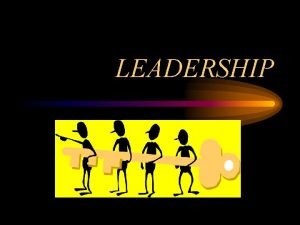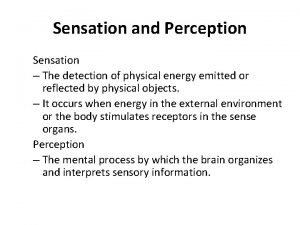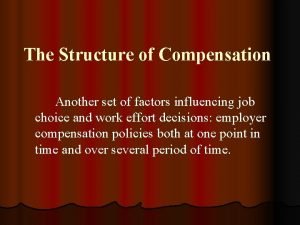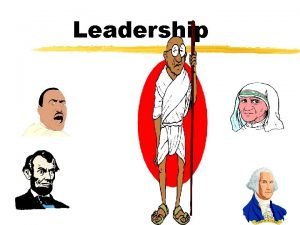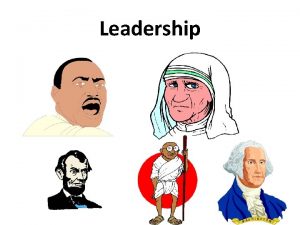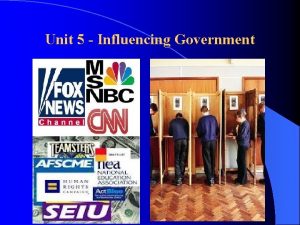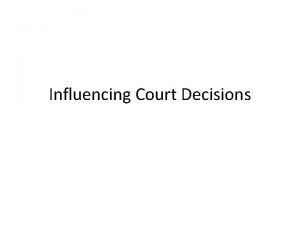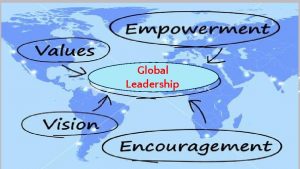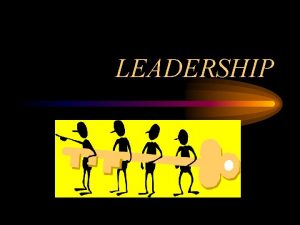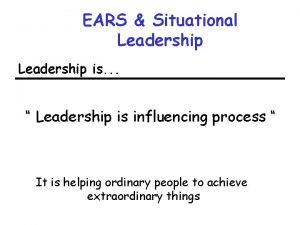Leadership What is leadership Leading people Influencing people
























- Slides: 24

Leadership

What is leadership? Leading people Influencing people Commanding people Guiding people

Leadership z The ability to influence a group toward the achievement of goals z “When you boil it down, contemporary leadership seems to a matter of aligning people toward common goals and empowering them to take the actions needed to reach them. ” Sherman, 1995 z Sanctioned vs. non sanctioned leadership

Types of Leaders z. Leader by the position achieved z. Leader by personality, charisma z. Leader by moral example z. Leader by power held z. Intellectual leader z. Leader because of ability to accomplish things

Managers vs. Leaders Managers z. Focus on things z. Do things right z. Plan z. Organize z. Direct z. Control z. Follows the rules Leaders z. Focus on people z. Do the right things z. Inspire z. Influence z. Motivate z. Build z. Shape entities

Leadership Roles z Mintzberg published his Ten Management Roles in his book, "Mintzberg on Management: Inside our Strange World of Organizations, " in 1990. z The ten roles are: z Figurehead. z Leader. z Liaison. z Monitor. z Disseminator. z Spokesperson. z Entrepreneur. z Disturbance Handler. z Resource Allocator. z Negotiator.

z The 10 roles are then divided up into three categories, as follows: z Interpersonal Figurehead Leader Liaison z Informational Monitor Disseminator Spokesperson z Decisional Entrepreneur Disturbance Handler Resource Allocator Negotiator

Interpersonal Category z The roles in this category involve providing information and ideas. z Figurehead - As a manager, you have social, ceremonial and legal responsibilities. You're expected to be a source of inspiration. People look up to you as a person with authority, and as a figurehead. z Leader - This is where you provide leadership for your team, your department or perhaps your entire organization; and it's where you manage the performance and responsibilities of everyone in the group. z Liaison - Managers must communicate with internal and external contacts. You need to be able to network effectively on behalf of your organization.

Informational Category z Monitor - In this role, you regularly seek out information related to your organization and industry, looking for relevant changes in the environment. You also monitor your team, in terms of both their productivity, and their well-being. z Disseminator - This is where you communicate potentially useful information to your colleagues and your team. z Spokesperson - Managers represent and speak for their organization. In this role you're responsible for transmitting information about your organization and its goals to the people outside it.

Decisional Category z Entrepreneur - As a manager, you create and control change within the organization. This means solving problems, generating new ideas, and implementing them. z Disturbance Handler - When an organization or team hits an unexpected roadblock, it's the manager who must take charge. You also need to help mediate disputes within it. z Resource Allocator - You'll also need to determine where organizational resources are best applied. This involves allocating funding, as well as assigning staff and other organizational resources. z Negotiator - You may be needed to take part in, and direct, important negotiations within your team, department, or organization

Common Activities z. Planning z. Organizing z. Directing z. Controlling

Planning Manager z. Planning z. Budgeting z. Sets targets z. Establishes detailed steps z. Allocates resources Leader z. Devises strategy z. Sets direction z. Creates vision

Organizing Manager z. Creates structure z. Job descriptions z. Staffing z. Hierarchy z. Delegates z. Training Leader z. Gets people on board for strategy z. Communication z. Networks

Directing Work Manager z. Solves problems z. Negotiates z. Brings to consensus Leader z. Empowers people z. Cheerleader

Controlling Manager z. Implements control systems z Performance measures z. Identifies variances z. Fixes variances Leader z Motivate z. Inspire z. Gives sense of accomplishment

Leadership Traits z. Intelligence y. More intelligent than non-leaders y. Scholarship y. Knowledge y. Being able to get things done z. Physical y. Doesn’t see to be correlated z. Personality y. Verbal facility y. Honesty y. Initiative y. Aggressive y. Self-confident y. Ambitious y. Originality y. Sociability y. Adaptability

Leadership Styles z. Delegating y. Low relationship/ low task y. Responsibility y. Willing employees z. Participating y. High relationship/ low task y. Facilitate decisions y. Able but unwilling z. Selling y. High task/high relationship y. Explain decisions y. Willing but unable z. Telling y. High Task/Low relationship y. Provide instruction y. Closely supervise

New Leaders Take Note z. General Advice y. Take advantage of the transition period y. Get advice and counsel y. Show empathy to predecessor y. Learn leadership z. Challenges y. Need knowledge quickly y. Establish new relationships y. Expectations y. Personal equilibrium

New Leader Traps z. Not learning z. Captured by quickly wrong people z. Isolation z. Successor syndrome z. Keeping existing team

Seven Basic Principles z. Have two to three years to make measurable financial and cultural progress z. Come in knowing current strategy, goals, and challenges. Form hypothesis on operating priorities z. Balance intense focus on priorities with flexibility on implementation….

Seven Basic Principles, con’t z. Decide about new organization architecture z. Build personal credibility and momentum z. Earn right to transform entity z. Remember there is no “one” way to manage a transition

Core Tasks z. Create Momentum z. Master technologies of learning, visioning, and coalition building z. Manage oneself

Create Momentum z. Learn and know about company z. Securing early wins y. First set short term goals y. When achieved make a big deal y. Should fit long term strategy z. Foundation for change y. Vision of how the organization will look y. Build political base to support change y. Modify culture to fit vision

Create Momentum z. Build credibility y. Demanding but can be satisfied y. Accessible but not too familiar y. Focused but flexible y. Active y. Can make tough calls but humane
 It involves leading influencing
It involves leading influencing Bobbin leading principle
Bobbin leading principle Liberty leading the people 1830
Liberty leading the people 1830 Liberty leading the people, 1830
Liberty leading the people, 1830 Vincent ogé
Vincent ogé Liberty leading the people, 1830
Liberty leading the people, 1830 Eugene delacroix liberty
Eugene delacroix liberty Liberty leading the people
Liberty leading the people Define personality and its determinants
Define personality and its determinants Basic carburetor diagram
Basic carburetor diagram Factors influencing distribution network
Factors influencing distribution network Local and systemic factors affecting wound healing
Local and systemic factors affecting wound healing Process of influencing others
Process of influencing others 5 influencing styles
5 influencing styles What is the shape of the trajectory of a projectile? *
What is the shape of the trajectory of a projectile? * Advantages and disadvantages of parliamentary law making uk
Advantages and disadvantages of parliamentary law making uk Physical factors influencing agriculture
Physical factors influencing agriculture A model of destination image formation
A model of destination image formation Factors influencing the choice of programming language
Factors influencing the choice of programming language Enforced non volitional attention
Enforced non volitional attention Factors influencing compensation philosophy
Factors influencing compensation philosophy Lifestyle factors affecting oxygenation
Lifestyle factors affecting oxygenation Oxidation weathering
Oxidation weathering Factors influencing t&d
Factors influencing t&d Factors influencing faculty staff relationship
Factors influencing faculty staff relationship


